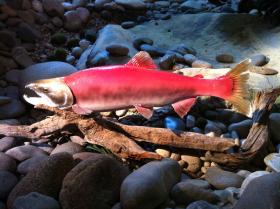forum
library
tutorial
contact

Lonesome Larry Hits 20-Year Anniversary
by Aaron KunzNorthwest Public Radio, July 19, 2012
|
the film forum library tutorial contact |

|
Lonesome Larry Hits 20-Year Anniversaryby Aaron KunzNorthwest Public Radio, July 19, 2012 |
 This year is the twenty year anniversary of Lonesome Larry, a lone sockeye salmon that made the 800 mile trip from the ocean to Redfish Lake in central Idaho. It helped jump start a multi-billion dollar effort to save Snake River salmon from certain extinction. Earthfix reporter Aaron Kunz explains.
This year is the twenty year anniversary of Lonesome Larry, a lone sockeye salmon that made the 800 mile trip from the ocean to Redfish Lake in central Idaho. It helped jump start a multi-billion dollar effort to save Snake River salmon from certain extinction. Earthfix reporter Aaron Kunz explains.
Lonesome Larry wasn't a large salmon - in fact he was barely a foot long. Sockeye aren't the largest species of salmon. An average Chinook is typically twice that size or larger. But Lonesome Larry didn't care, he swam upriver past eight gigantic federal dams, up raging waterfalls and past countless natural predators. The journey means climbing nearly 6500 vertical feet. He was the lone sockeye to complete the journey in 1992.
Barker: "Lonesome Larry 20 years ago was the last fish. One fish and maybe a couple more the next year."
Rocky Barker wrote about Lonesome Larry recently in the Idaho Statesman - this year is the 20th anniversary of that journey from the ocean.
Today, more than a thousand sockeye make that same journey. Traveling tail first to the ocean as juveniles. *Exploring the Pacific Ocean for food before heading back to the very gravel beds where they were born deep in Idaho's mountains.
Barbara Gudgel lives near Redfish Lake and often watches returning sockeye in the fall.
Gudgel: "It's amazing they know their way back. They come back home where they were born and raised. It's just amazing. There is nothing in nature like it."
Lonesome Larry is a reminder of the decline of Idaho's salmon. Two hundred years ago - biologists believe salmon were icons of abundance. Wesley Oatman, a member of the Nez Perce Indian Tribe says even his ancestors had a hard time describing the abundance.
Oatman: "I can't imagine putting a number on the amount of fish that were here at one time. I would say in the the ten to twenty million range. I know it is a multi-million fish industry at one time for us."
Every summer, Wesley and his family continue their fishing heritage. He is fishing along the banks of Rapid River near Riggins - about three hours north of Boise. He uses a net attached to a long pole and scoops large Chinook Salmon from the river. Only tribal members are allowed to fish here - protected by treaty.
Oatman: "It's what I do every year. I've been bred to do this you know. We're a salmon people.
By 1991, sockeye salmon in Idaho were practically gone. The annual returns were in the single digits. Everything changed that year, the federal government listed the sockeye salmon on the Endangered Species List. The government acted at the urging of the Shoshone Bannock Tribes. *Federal protections for wildlife in danger of extinction. Rocky Barker was a journalist covering the salmon in the early 90's.
Barker: "We all kind of all at once rediscovered this fish that really is such an icon for the whole region."
Snake River Chinook were also listed as threatened. That started an effort to save the salmon.
The cost of preserving salmon in the Northwest runs into the hundreds of millions of dollars every year. And it's a project that won't end anytime soon.
Bonneville Power Administration manages the power generated at the eight federal dams on the mainstem of the Columbia River and the lower Snake River. Because salmon are federally protected, BPA spends millions to help salmon recovery efforts.
Jason Sweet is a staff biologist for the BPA.
Sweet: "Annually, it is close to $240 million a year for our overall program."
The money pays for hatcheries to mitigate for the loss of salmon caused by dams. It helps pay for barging and trucking of juvenile salmon downriver so they avoid the hydroelectric turbines altogether. And it pays for habitat recovery that benefits returning adult salmon.
But some like Bert Bowler with Salmon Solutions - a salmon advocacy group says the real solution is tearing down the dams.
Bowler: "If we are going to recover Snake River salmon and Steelhead, it's going to require dam removal. Period - and the science pretty much says that."
Not every agrees with Bowler, hydropower provides sixty percent of the electricity in the Northwest.
Terry Flores with Northwest River Partners promotes the benefits of hydropower. She says hydropower in the Northwest cuts carbon emission in half over other parts of the country. Dams also provide affordable energy.
But the loss of salmon isn't an option either. They are a keystone species, providing vital elements to a wide variety of plants and animals.
Tom Stuart - a lifelong fisherman explains.
Stuart: "But in Idaho our entire state has in fact been fertilized by ions of big salmon returning to Idaho to spawn and die and fertilize our watersheds and our landscapes."
This is not just important for Idaho but for many places like Washington and Oregon with rivers and streams.
Politically, finding a solution that benefits salmon has been slow. The creation of a federal salmon management plan has been tied up in court for two decades and continues at least until 2014. The issue of federal dam removal may rest on Congress. They funded the dams and are the only ones who can order them removed. That isn't likely to happen anytime soon.
learn more on topics covered in the film
see the video
read the script
learn the songs
discussion forum
